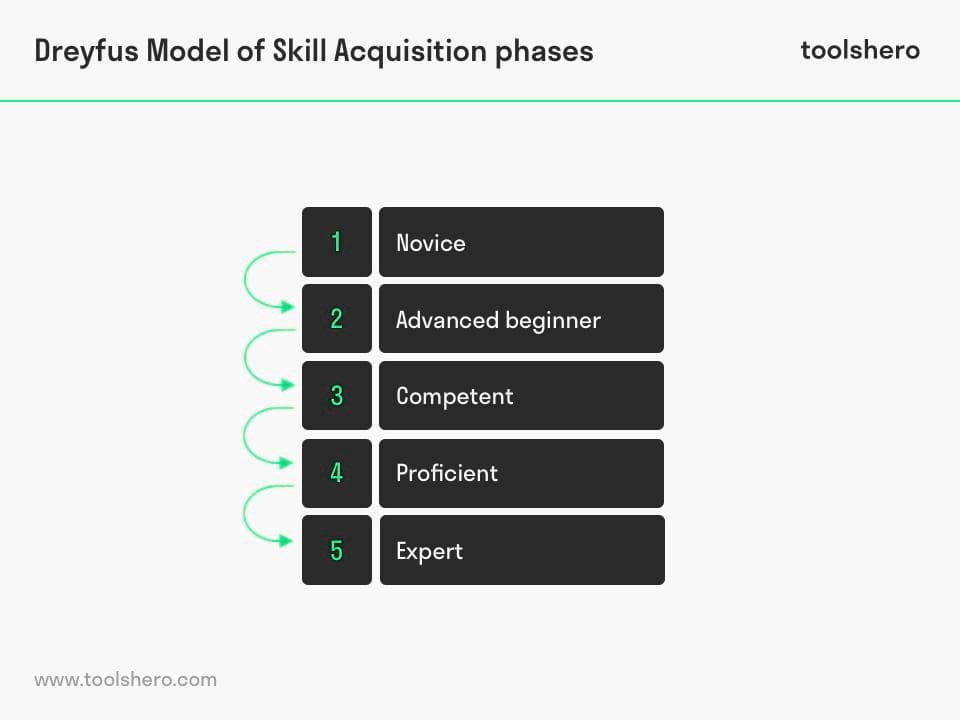Dreyfus Model of Skill Acquisition

Dreyfus model of skill acquisition: this article provides a practical explanation of the Dreyfus model of skill acquisition. After reading, you’ll understand the basics of this powerful personal development tool.
What is the Dreyfus Model of Skill Acquisition?
The Dreyfus model of skill acquisition is a model that can be used to assess the level of development of competencies and skills of people who are learning something new.
According to the Dreyfus Model of Skill Acquisition, people learn from direct instructions and practice. It assumes that the longer one practice by following rules and procedures, he or she becomes more experienced and more competent in a job or task. Eventually, as one becomes more experienced, he or she no longer rely on the direct rules and procedures.
Stuart and Hubert Dreyfus created the Dreyfus model of skill acquisition in 1980, and it is today still a frequently used model to assess the level of experience of an individual. The Dreyfus brothers’ research found that one who practices a job or task will go through the following five different phases:
- Novice
- Advanced beginner
- Competent
- Proficient
- Expert

Figure 1 – the phases of skill acquisition
1. Novice
In the novice phase of the Dreyfus model of skill acquisition, it is expected that the student has no background in the task or job. It is for this reason, crucial for the student to follow direct orders, rules, and procedures.
Since everything is new, the chance is low that the student can be creative because he or she is not experienced in the field.
The Dreyfus model of skill acquisition expects that the student is unable to make its own decisions yet, and for this reason, he or she is still learning the basic by following the orders.
The most important part of this phase is that the student must obtain a thorough understanding of the context of the information that is shared.
2. Advanced beginner
In this phase, The Dreyfus model of skill acquisition expects that the student has seen and practiced with various examples of a task or job. For this reason, it will be easier for the student to deal with different scenarios because he or she will recognize those from previous experiences.
Because the student has obtained some background, he or she feels more confident to execute a task or job. But if something goes wrong, the likelihood that the student will blame the rules is high.
According to the Dreyfus model of skill acquisition, it happens because the student might believe that a rule or guideline may apply to every situation.
For this reason, the student might have a lower sense of responsibility, and thus, still need support in this phase.
3. Competent
The complexity of a job or task determines the speed at which a student reaches the level of competence. According to the Dreyfus Model of Skill Acquisition, it is expected that a student needs approximately 2 to 3 years before he or she becomes competent.
Again, the time required to have a competent performance depends on the type of job. For example, to become a competent surgeon, it might take more than three years to become competent in the position. But a marketer could learn a lot of skills, competencies, and knowledge in these three years.
In general, it is expected that an individual with a competent performance can work efficient, organized, and knows what he or she is doing based on previous experiences.
Another essential element of a competent individual is that he or she has a sense of responsibility, and thus, think in solutions.
According to the Dreyfus model of skill acquisition, competent individuals know many rules and procedures. Because of this, it is sometimes difficult to apply those to every situation.
They must be selective in choosing which rules and procedures to use to solve problems. It can also be difficult because they might be working under pressure.
4. Proficient
According to the Dreyfus model of skill acquisition, when an individual reaches this phase, he or she is good in a job or task. A proficient individual knows its boundaries, but the way how to handle particular situations sometimes remains unclear.
This is because many times, creative solutions have to be created when a problem occurs. It is only possible to solve these kinds of issues when the proficient individual is experienced with the task.
According to the Dreyfus model of skill acquisition, when one is proficient in a job or task, he or she sees the critical aspects of situations. Because of this, the individual can prioritize effectively and make decisions more quickly.
5. Expert
This is the last stage of the Dreyfus model of skill acquisition, and it is expected that the individual does not need direct rules, guidelines, and procedures anymore to execute a job.
Due to a broad exposure, and thus, extensive experience in the field, the expert unconsciously applies appropriate rules and guidelines to any situation. If for some reason a task occurs which is also new to the expert, the Dreyfus model of skill acquisition expects that the expert uses its analytical skills to assess the situation and identify which elements he or she is already experienced with.
The essential element of an expert is that the individual uses personal intuition to achieve the most significant results. However, it is difficult to identify an expert because experts usually do not recognize themselves as experts.
Experts find difficulties in explaining their specialties. For this reason, experts are many times acknowledged by, for example, their coworkers.
Practical example of the Dreyfus model of skill acquisition
Please consider the following examples of each stage of the Dreyfus model of skill acquisition:
1. Novice
Consider the following example: A student who wants to learn to drive a car and who have never driven a car before must first learn automobile and road theory such as speed limits, priority rules, and special maneuvers.
After this knowledge has been obtained, the student has to practice putting the theory into practice. However, driving on the real road is different than learning how to drive from a book.
It will take time and practice before the student exactly knows what to do in every situation. For this reason, he or she must first follow direct orders from the instructor until the student thoroughly understand what to do in every situation.
2. Advanced beginner
Consider the following example, which is a follow-up on the previous example. As the student now knows how to handle the wheel, and he or she knows the rules, it happens that the student approach an intersection where the student has priority. However, another motorist who also approach the intersection and who has no priority takes the initiative to take priority.
The instructor is forced the apply the brakes to prevent an accident. Both the student and instructor are in shock, and as a consequence, the student argues that the other motorist had no priority and that it is not the students’ fault.
This is a typical example of an advanced beginner because although the student knows the rules and knows how to apply those, the student must also be responsible for identifying other motorists’ mistakes and anticipate on those.
3. Competent
Consider the following example: brand manager Steve of brand XYZ was offered a local opportunity by an entrepreneur to contribute to sponsoring an event that attracts thousands of visitors and that positively influence the brand on the local market.
Steve got excited, but he knew that if he had to pay the sole entrepreneur directly, it would involve a lengthy legal process.
As a solution, Steve asked his PR agency to put the entrepreneur on their payroll so he could avoid the legal process and sponsor the event on short-term. Steve knows the rules and procedures, but he managed to find a solution for a short-term. In this way, he could sponsor the event, and the amount sponsored would be deducted from his PR budget.
4. Proficient
Consider the following example of a nurse who is under the supervision of a gynecologist. As an expectant mother is about to give birth, the nurses in the hospital take care of the pregnant mother.
However, the patient is in terrible pain and request medication for a smoother process of giving birth. The nurse next provides explanations of the possibilities, but they still have to consult with the gynecologist before a final decision can be made.
In this example, the nurses knew what to do. They are proficient in the job, but before a final decision can be made, they have to consult with the expert, who is this case is the gynecologist.
5. Expert
Consider the following example of an experienced motorcycle mechanic: a motorcyclist bought a second-hand motorcycle a year ago.
During the year, the motorcyclist did not notice anything wrong with the bike. However, after a year, he experienced some vibrations, and he thinks that the horsepower of the bike diminished. As a consequence, the motorcyclist decides to go to the motorcyclist mechanic for a checkup.
Consequently, the motorcycle mechanic started the engine and plays with the throttle in neutral gear. He additionally smelled the motor oil reservoir and was able to tell the motorcyclist that the clutch plate is worn out and that the valves must be reset.
Because of the years of experience of the motorcycle mechanic, he did not need to follow guidelines to identify the problem with the motorcycle. He could hear and smell what was wrong with the bike.
Conclusion of the Dreyfus Model of Skill Acquisition
The different stages of the Dreyfus model of skill acquisition require time and practice. It is crucial for every student, regardless of the type of job or industry, to first follow direct rules and guidelines to learn a task.
After the student gets more experienced, he or she will reach higher stages in the model, such as becoming proficient or an expert. In general, the model claims that the more experienced an individual is in a task, the less dependent he or she is on rules and guidelines to execute a job or task. In addition, it is expected that the more experienced an individual is, such as an expert, the better the person can deal with unexpected events.
The Dreyfus model of skill acquisition is useful to understand the level of development of any individual in any job. It also enables coaches to identify which elements a coach or student can be improved to reach a higher level of competence.
It is important to understand that no one can be a beginner or an expert in everything. For this reason, it is best to use the model to asses an individual’s performance and how this correlates with the required skills and competences of a job or task.
Now it’s your turn
What do you think? Do you recognize the explanation of the Dreyfus Model of Skill Acquisition? Have you assed yourself or others in your workplace according to this model? Do you have any tips or additional comments?
Share your experience and knowledge in the comments box below.
More information
- Benner, P. (2004). Using the Dreyfus model of skill acquisition to describe and interpret skill acquisition and clinical judgment in nursing practice and education. Bulletin of science, technology & society, 24(3), 188-199.
- Carraccio, C. L., Benson, B. J., Nixon, L. J., & Derstine, P. L. (2008). From the educational bench to the clinical bedside: translating the Dreyfus developmental model to the learning of clinical skills. Academic Medicine, 83(8), 761-767.
- Dreyfus, S. E., & Dreyfus, H. L. (1980). A five-stage model of the mental activities involved in directed skill acquisition (No. ORC-80-2). California Univ Berkeley Operations Research Center.
- Lyon, L. J. (2015). Development of teaching expertise viewed through the Dreyfus model of skill acquisition. Journal of the Scholarship of Teaching and Learning, 88-105.
How to cite this article:
Zeeman, A. (2019). Dreyfus Model of Skill Acquisition. Retrieved [insert date] from Toolshero: https://www.toolshero.com/human-resources/dreyfus-model-of-skill-acquisition/
Published on: 12/10/2019 | Last update: 08/22/2023
Add a link to this page on your website:
<a href=”https://www.toolshero.com/human-resources/dreyfus-model-of-skill-acquisition/”>Toolshero: Dreyfus Model of Skill Acquisition</a>













One response to “Dreyfus Model of Skill Acquisition”
Very helpful, thankyou.